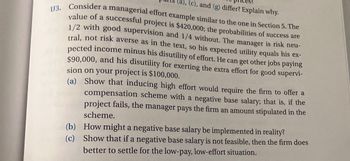
ENGR.ECONOMIC ANALYSIS
14th Edition
ISBN: 9780190931919
Author: NEWNAN
Publisher: Oxford University Press
expand_more
expand_more
format_list_bulleted
Question
Can you help solve parts A through C. For part C please refer to the question posted here "Suppose a negative salary is not feasible. If you give a base salary of 0, what payment would you give in the event of success in order to induce high effort and participation?"

Transcribed Image Text:(a), (c), and (g) differ? Explain why.
U3. Consider a managerial effort example similar to the one in Section 5. The
value of a successful project is $420,000; the probabilities of success are
1/2 with good supervision and 1/4 without. The manager is risk neu-
tral, not risk averse as in the text, so his expected utility equals his ex-
pected income minus his disutility of effort. He can get other jobs paying
$90,000, and his disutility for exerting the extra effort for good supervi-
sion on your project is $100,000.
(a) Show that inducing high effort would require the firm to offer a
compensation scheme with a negative base salary; that is, if the
project fails, the manager pays the firm an amount stipulated in the
scheme.
(b) How might a negative base salary be implemented in reality?
(c) Show that if a negative base salary is not feasible, then the firm does
better to settle for the low-pay, low-effort situation.
Expert Solution
This question has been solved!
Explore an expertly crafted, step-by-step solution for a thorough understanding of key concepts.
This is a popular solution
Trending nowThis is a popular solution!
Step by stepSolved in 4 steps

Knowledge Booster
Learn more about
Need a deep-dive on the concept behind this application? Look no further. Learn more about this topic, economics and related others by exploring similar questions and additional content below.Similar questions
- True/False Increase in total product always indicates that there are increasing returns to a factor.arrow_forwardYour boss is impressed with your performance over the past year and has decided to give you a 5% increase in your salary. Are you clearly better off with your increased salary? What factors must be considered?arrow_forwardHow can a managerial econmist help in operations of: (a) a service organization; (b) manufacturing; (c) an agricultural - based company.arrow_forward
- Health and safety regulations in the labor market Multiple Choice O O are always efficient because they improve working conditions. should be evaluated by comparing their costs to their benefits. can lead to an increase in frictional unemployment. Saved are necessarily inefficient if they impose additional costs on employers.arrow_forwardExplicit cost = $100 Implicit cost = $163 Total cost = ?arrow_forwardBased on the graph below, how much is the marginal product of labour of the sixth worker, if Q5=67 units per period and Q6=88. Q in Units/period Q6 Q5 6. Lin Workers/period Ca15 units per peciodarrow_forward
arrow_back_ios
arrow_forward_ios
Recommended textbooks for you

 Principles of Economics (12th Edition)EconomicsISBN:9780134078779Author:Karl E. Case, Ray C. Fair, Sharon E. OsterPublisher:PEARSON
Principles of Economics (12th Edition)EconomicsISBN:9780134078779Author:Karl E. Case, Ray C. Fair, Sharon E. OsterPublisher:PEARSON Engineering Economy (17th Edition)EconomicsISBN:9780134870069Author:William G. Sullivan, Elin M. Wicks, C. Patrick KoellingPublisher:PEARSON
Engineering Economy (17th Edition)EconomicsISBN:9780134870069Author:William G. Sullivan, Elin M. Wicks, C. Patrick KoellingPublisher:PEARSON Principles of Economics (MindTap Course List)EconomicsISBN:9781305585126Author:N. Gregory MankiwPublisher:Cengage Learning
Principles of Economics (MindTap Course List)EconomicsISBN:9781305585126Author:N. Gregory MankiwPublisher:Cengage Learning Managerial Economics: A Problem Solving ApproachEconomicsISBN:9781337106665Author:Luke M. Froeb, Brian T. McCann, Michael R. Ward, Mike ShorPublisher:Cengage Learning
Managerial Economics: A Problem Solving ApproachEconomicsISBN:9781337106665Author:Luke M. Froeb, Brian T. McCann, Michael R. Ward, Mike ShorPublisher:Cengage Learning Managerial Economics & Business Strategy (Mcgraw-...EconomicsISBN:9781259290619Author:Michael Baye, Jeff PrincePublisher:McGraw-Hill Education
Managerial Economics & Business Strategy (Mcgraw-...EconomicsISBN:9781259290619Author:Michael Baye, Jeff PrincePublisher:McGraw-Hill Education


Principles of Economics (12th Edition)
Economics
ISBN:9780134078779
Author:Karl E. Case, Ray C. Fair, Sharon E. Oster
Publisher:PEARSON

Engineering Economy (17th Edition)
Economics
ISBN:9780134870069
Author:William G. Sullivan, Elin M. Wicks, C. Patrick Koelling
Publisher:PEARSON

Principles of Economics (MindTap Course List)
Economics
ISBN:9781305585126
Author:N. Gregory Mankiw
Publisher:Cengage Learning

Managerial Economics: A Problem Solving Approach
Economics
ISBN:9781337106665
Author:Luke M. Froeb, Brian T. McCann, Michael R. Ward, Mike Shor
Publisher:Cengage Learning

Managerial Economics & Business Strategy (Mcgraw-...
Economics
ISBN:9781259290619
Author:Michael Baye, Jeff Prince
Publisher:McGraw-Hill Education